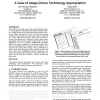Free Online Productivity Tools
i2Speak
i2Symbol
i2OCR
iTex2Img
iWeb2Print
iWeb2Shot
i2Type
iPdf2Split
iPdf2Merge
i2Bopomofo
i2Arabic
i2Style
i2Image
i2PDF
iLatex2Rtf
Sci2ools
ACMDIS
2008
ACM
2008
ACM
Paper interface to electronic medical records: a case of usage-driven technology appropriation
We conducted a 6-month project with a physical therapy clinic, involving equal parts ethnographic fieldwork and rapid prototyping. It differed from most reported user-informed design by having an explicit dual purpose. On the one hand, the prototype should provide significant, measurable improvements for the field site. On the other hand, the project sponsor did not intend to develop the prototype into a product but rather identify future opportunities and needs in the small-to-medium health care sector, requirements for next generation multifunction peripherals (MFPs), and business applications of existing technology. Thus, the project simultaneously investigated specific solutions for a specific work practice while looking for key technologies to address future needs. This paper provides a detailed account of the process and results, highlighting particular contingencies that come with a dual-purpose exploration, as well as the benefits of a small, focused team that "oscillates...
ACMDIS 2008 | Explicit Dual Purpose | Human Computer Interaction | Parts Ethnographic Fieldwork | Rapid Prototyping |
| Added | 12 Oct 2010 |
| Updated | 12 Oct 2010 |
| Type | Conference |
| Year | 2008 |
| Where | ACMDIS |
| Authors | Elin Rønby Pedersen, Greg Wolff |
Comments (0)

